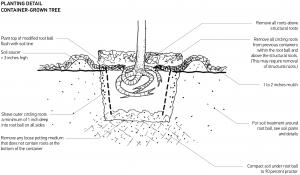
image source: James R. Urban, FASLA
Foliage Footprints: Urban trees, soil & carbon. Tools to improve trees in cities
Authors: Garrett McGill, David McKenna, Ang Zhai
Newly planted urban street trees, too often do not live long enough to sequester enough carbon to compensate for their intensive production & establishment. Landscape architects decide exactly where a tree goes and how it will be planted. We have the primary burden to get the science right. Foliage Footprints explores the complexities and challenges of urban tree planting and the critical role landscape architects play in ensuring the success of urban trees. We dive into the hidden climate costs associated with urban trees, emphasizing the need for more informed decision-making by designers.
The discussion centers on the concept of “functional trees” – those that provide significant environmental benefits and survive long enough to outweigh the carbon costs of their production and establishment. A key revelation is the shocking 16-year timeframe it takes for an average urban tree to compensate for initial carbon emissions. Our interviews reveal tools for designer to draw details for tree pits that allow trees to thrive.
Designers must not accept difficult growing conditions, we must make a strong case to improve soil conditions to grow trees that meet our design goals. Landscape architects must lead the change by enforcing stricter standards and specifications for tree planting. Embrace your role as stewards of urban greenery be the catalyst for positive environmental change.
Featured guest speakers
Jack Tupper, registered Landscape Architect with the City of Vancouver. He has a background in residential development, park master plans and neighbourhood design across the UK, Switzerland and Canada. His work focuses upon sustainable and ecological interventions within the urban realm.
Adam Nicklin, principal and co-founder PUBLIC WORK, is a landscape architect and urban designer with over 20 years of experience in the UK, USA, and Canada. Adam has served as a member of the City of Toronto Design Review Panel. Prior to co-founding PUBLIC WORK, Adam was principal at DTAH.
James Urban, FASLA, is known for his expertise in urban arboriculture, soil preservation, and tree installation in urban environments. He has authored Up by Roots, published by the International Society of Arboriculture, and has lectured extensively on urban soils and tree planting at Harvard University and other universities in the US. He’s recognized for his innovations in urban tree planting techniques, including structural cells (Silva Cells).
Resources
Quick reads
Planting details (pdf + dwg)
- James Urban: Tree planting details and specifications
- Tree Planting Solutions in Hard Boulevard Surfaces: Best Practices Manual City of Toronto
-
Construction Specifications and Drawings for Green Infrastructure City of Toronto
Further reading
- Swedish Study: How Green Is An Urban Tree?
- The Salt Dilemma: Growing Better Urban Trees in Northern Climates
- The Case For Big Tree Openings
- Soil profiling rebuilding
- Urban Tree Foundation
Bibliography
Ingram, Dewayne L. and Charles R. Hall. “Carbon Footprint and Related Production Costs of Pot-in-Pot System Components for Red Maple using Life Cycle Assessment.” Journal of Environmental Horticulture 33, no. 3 (2015): 103-109.
Ingram, Dewayne L., Charles R. Hall, and Joshua Knight. “Understanding Carbon Footprint in Production and Use of Landscape Plants”, HortTechnology hortte 29, 1 (2019): 6-10, accessed Oct 21, 2023, https://doi.org/10.21273/HORTTECH04220-18
Ingram, Dewayne L. “Life Cycle Assessment of a Field-Grown Red Maple Tree to Estimate its Carbon Footprint Components.” The International Journal of Life Cycle Assessment 17, no. 4 (2012): 453-462.
Lind, Erik, Thomas Prade, Johanna Sjöman Deak, Anna Levinsson, and Henrik Sjöman. “How Green is an Urban Tree? the Impact of Species Selection in Reducing the Carbon Footprint of Park Trees in Swedish Cities.” Frontiers in Sustainable Cities 5, (2023).
Strohbach, Michael W., Eric Arnold, and Dagmar Haase. “The Carbon Footprint of Urban Green space—A Life Cycle Approach.” Landscape and Urban Planning 104, no. 2 (2012): 220-229.